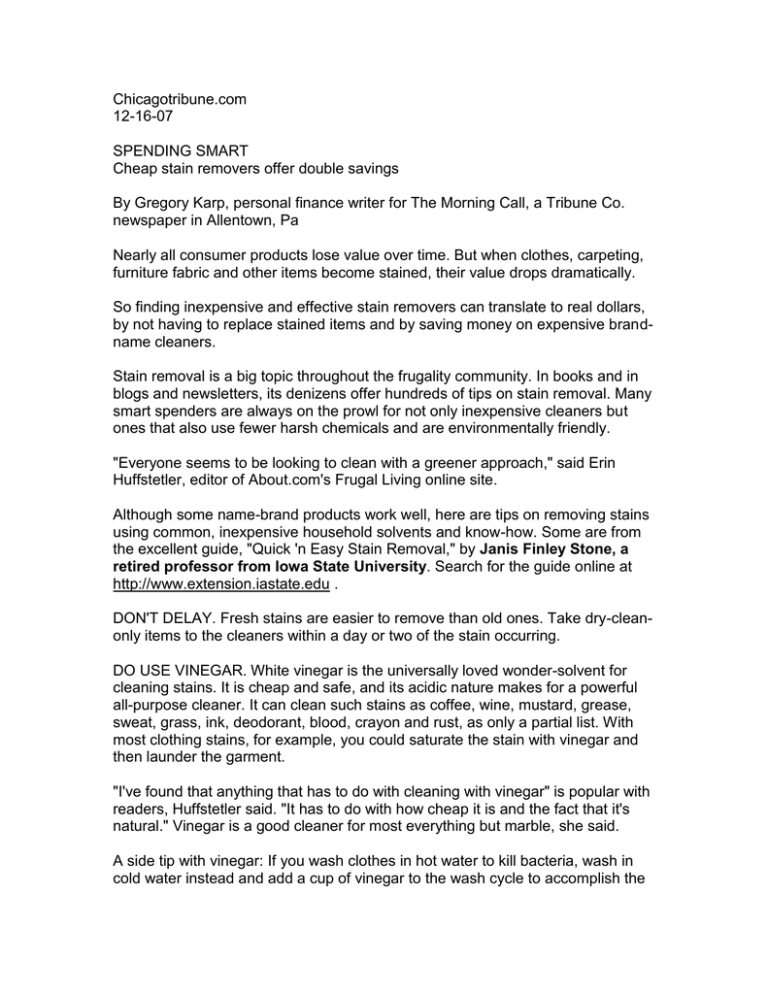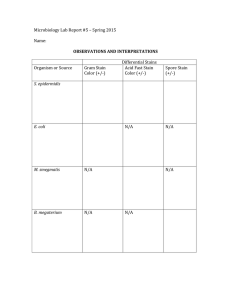Chicagotribune.com 12-16-07 SPENDING SMART
advertisement

Chicagotribune.com 12-16-07 SPENDING SMART Cheap stain removers offer double savings By Gregory Karp, personal finance writer for The Morning Call, a Tribune Co. newspaper in Allentown, Pa Nearly all consumer products lose value over time. But when clothes, carpeting, furniture fabric and other items become stained, their value drops dramatically. So finding inexpensive and effective stain removers can translate to real dollars, by not having to replace stained items and by saving money on expensive brandname cleaners. Stain removal is a big topic throughout the frugality community. In books and in blogs and newsletters, its denizens offer hundreds of tips on stain removal. Many smart spenders are always on the prowl for not only inexpensive cleaners but ones that also use fewer harsh chemicals and are environmentally friendly. "Everyone seems to be looking to clean with a greener approach," said Erin Huffstetler, editor of About.com's Frugal Living online site. Although some name-brand products work well, here are tips on removing stains using common, inexpensive household solvents and know-how. Some are from the excellent guide, "Quick 'n Easy Stain Removal," by Janis Finley Stone, a retired professor from Iowa State University. Search for the guide online at http://www.extension.iastate.edu . DON'T DELAY. Fresh stains are easier to remove than old ones. Take dry-cleanonly items to the cleaners within a day or two of the stain occurring. DO USE VINEGAR. White vinegar is the universally loved wonder-solvent for cleaning stains. It is cheap and safe, and its acidic nature makes for a powerful all-purpose cleaner. It can clean such stains as coffee, wine, mustard, grease, sweat, grass, ink, deodorant, blood, crayon and rust, as only a partial list. With most clothing stains, for example, you could saturate the stain with vinegar and then launder the garment. "I've found that anything that has to do with cleaning with vinegar" is popular with readers, Huffstetler said. "It has to do with how cheap it is and the fact that it's natural." Vinegar is a good cleaner for most everything but marble, she said. A side tip with vinegar: If you wash clothes in hot water to kill bacteria, wash in cold water instead and add a cup of vinegar to the wash cycle to accomplish the same thing, saving money on hot water in the process, Huffstetler said. DON'T USE SOAP. Never rub a fresh stain with a bar soap. Soap sets many stains. Also, avoid using hot water on stains of unknown origin. Hot water can set protein stains such as milk, egg and blood. Similarly, don't iron or press stained fabrics. Heat will set most stains. DO USE BAKING SODA. Baking soda seems to be runner-up to vinegar in mostbeloved stain removers, working on stained countertops, for example. And mixing vinegar and baking soda to make a paste can be a good cleaner for stained carpets, Huffstetler said. Let the paste dry and vacuum it up. Baking soda is also good for treating odors. Another soda, club soda, can be a handy solvent when you are at a restaurant and slop food on clothing. DON'T TOWEL IT. Avoid rubbing the stained area with a lint-covered terry towel or a dark-colored cloth. You may complicate the problem. And avoid excessive rubbing unless the fabric is tough and durable. Rubbing can spread the stain and damage the fiber, finish or color. DO TRUST BUT VERIFY. Test stain-removal agents on a seam or hidden area to be sure it does not affect the color or finish of the fabric before starting on the stain. DON'T OVERLOOK WATER. It might seem obvious, but water alone can be a great solvent for removing stains. With all the powerful stain removers available, it's easy to overlook the cheapest and mostly widely available solvent of all. DO BE CAREFUL. Mixing solvents can be hazardous. For example, ammonia mixed with bleach gives off a hazardous chlorine gas. Even when using vinegar, which is fairly safe, you might want to wear gloves and avoid getting any in eyes, Huffstetler said. DON'T USE THESE. Some common suggestions for stain removal are bad advice, according to the "Quick 'n Easy Stain Removal" guide. Dishwasher detergent and hair spray can damage fabric or discolor. Milk does not remove ink and leaves a protein stain behind. Soaking clothes in salt water does not improve colorfastness. Shampoo might remove some light oil stains but is no better than regular laundry detergent and is more expensive. DO TREAT SPECIAL STAINS. For chewing gum, apply ice and crack off. Then pretreat with laundry detergent. For rust, apply salt and lemon juice and spread the garment in the sun to dry. Remove iodine with sodium thiosulfate, or what photo-supply stores call acid fixer. For lead pencil marks, use an art gum eraser, but avoid rubbing the fabric. Gregory Karp is a personal finance writer for The Morning Call, a Tribune Co. newspaper in Allentown, Pa. E-mail him at yourmoney@tribune.com.



